We cannot change teaching practices alone!

This communication presents the most striking facts of the evolution of pedagogical practices over ten academic years and illustrates that these changes, ultimately leading to personal and professional development, cannot take place in isolation, disconnected from other stakeholders in the field of pedagogy in higher education. Changes must necessarily be done by ”acting together”.
Keywords: Teaching practices, professional development, teaching support
1. Context
My participation in workshops offered by the newly established university teaching support service (Service Universitaire de la Pédagogie de l'Université d'Artois, SUPArtois) at the beginning of the 2013/2014 academic year made me deeply aware of how much teaching practices influence students' academic success and development. As a university professor teaching biochemistry for over 25 years, I certainly would not have reconsidered my teaching methods at this stage in my career without this experience. It profoundly shifted my perspective, leading me to embrace the practitioner-researcher role and explore the Scholarship of Teaching and Learning. The seed of this transformation was undoubtedly there, but it only germinated thanks to this fertile soil provided by SUPArtois. I conducted the student evaluation of teaching (SET) for the introductory biochemistry course in the Life Sciences curriculum. The analysis of the responses revealed a significant lack of motivation among students who struggled to see the relevance of this discipline in their training. It was clear - it was time to act.
2. Act together
We cannot change teaching practices alone. We need the synergy of all stakeholders: the teaching team, the teaching support service, and the students. The entire institution must be involved.
2.1. Act with the university teaching support service
SUPArtois was designed as a transdisciplinary and responsive structure for faculty and staff when it was established. It offers:
- reflective workshops on teaching and learning themes grounded in theoretical and practical frameworks to guide action,
- support that enables the transformation of teaching practices. Either individually or within teams,
- promotion of innovative educational projects through the Teaching Quality Bonus (Bonus Qualité Enseignement, BQE) the Pedagogical Innovation label (IP label), and
- gradually developed resources to support ongoing initiatives.
The BQE provides fundings to individuals or teams to facilitate a long-term transformation of teaching practices. The IP label recognizes the implementation of practices that highlight teaching quality and increase the institution's attractiveness to future students.
Over the years, I have participated in several workshops offered by SUPArtois (Table 1), and it is thanks to the exchanges with the facilitators that I have been able to develop my practices. Designated to encourage reflection, these workshops provide ideas without being prescriptive. At no point do the facilitators make value judgments or assume the role of arbiter of what constitutes good practices.
Table 1. Participation in SUPArtois workshops
|
Reflexive workshop type |
Theme of the reflexive workshop |
|
Develop teaching practices |
Better define learning objectives |
|
Designing an educational contract or how to engage our students in their learning from the first quarter of an hour |
|
|
Flipped classroom |
|
|
Have our students work in project mode or in teams |
Involve all our students in their team projects over time. Workshop in four sessions: design, animation, evaluation, contribution of LMS |
|
Evaluate learning |
Better evaluate our students’ learning / Develop a criteria grid |
|
Interact with our students |
How can we better motivate our students? |
I quickly recognized the value of formative assessment. I chose to use classroom response systems, or "clickers," to support first-year undergraduate students, as not all students had equal access to online applications at that time. For third-year undergraduates, I favored the use of online applications such as Klaxoon and Wooclap. Over time, I specialized in interactive facilitation methods for large groups and was eager to share these new skills by leading workshops myself (Table 2).
Table 2. Facilitation of SUPArtois workshops
|
Reflexive workshop type |
Theme of the reflexive workshop |
|
Develop teaching practices |
Formative assessments and ‘question-answer’ teaching sequences |
|
Consider and design ‘question-answer’ teaching sequences |
|
|
Interactivity tools |
|
|
How can we measure the effects of transforming our teaching practices? |
2.2. Act with the teaching team
The biochemistry course teaching team consisted of four teacher-researchers and two temporary instructors. From the very beginning, all colleagues were actively involved. We applied the principle of constructive alignment, introduced a learning contract, and gradually incorporated activities that encourage student participation while enhancing their understanding (Biggs, 1999).
Teaching resources were developed and made available through the learning management system (Moodle). The teaching team received BQEs for the creation of resources designated to enhance interaction and interactivity. Starting in the 2017/2018 academic year, the IP label was awarded to several teaching units, including biochemistry courses in the first and second years. We have always prioritized delivering a consistent message and ensuring fair treatment of all students despite their diversity and the large number of groups. This was made possible through feedback from team members following their interactions with students. Additionally, the challenges of teaching during COVID-19 pandemic strengthened communication within the teaching team, particularly through a dedicated Moodle forum and Zoom meetings.
2.3. Act with students
During the 2015/2016 academic year, an activity was introduced in the first lesson to analyze the learning contract. This involved peer discussion, teacher-student interactions, and a "question-and-answer" teaching sequence using clicker questions. We also sought student feedback on the proposed learning approach and aimed to enhance their understanding of practices necessary for success in the course.
Clicker question sequence were employed for formative assessment during lessons (Bruff, 2009), for revision after each chapter, and at the end of the semester. Longitudinal analyses conducted over several years enabled us to assess the impact of these changes on student success.
Findings revealed that students appreciated the teaching methods, leading to increased engagement and motivation. While real improvements in student satisfaction were observed, a saturation effect on the success rate emerged after four years, as a portion of the student body remained disengaged from the learning process (Karamanos et al., 2018).
One key strategy for improvement was to enhance cooperative activities among students to promote co-learning. For example, during tutorials, students worked in teams of four to solve exercises, which the teacher first validated before being discussed with another team (Karamanos et al., 2019). Observations highlighted the added value of this approach for student learning. The success rate improved significantly, rising from 2% to over 50% in six years (Figure 1).
However, a decline was observed during the COVID 19 period (2019/2020 and 2020/2021), primarily due to increased student dropouts. For those who remained engaged, we maintained interactions by expanding activities on Moodle (forum, chats) and facilitating teamwork through the group function in Zoom. It is worth noting that the sharp decrease in the correlation coefficient r² for the 2019/2020 academic year reflects the exceptional assessment methods implemented that year, as the semester was interrupted halfway through.
A grade could be assigned in biochemistry based on intermediate assessment and participation in activities, but a minimum grade of 10 was applied to the semester to calculate the annual average and allow compensation between semesters. This technical adjustment was only applied for that year. In the 2020/2021 academic year, all teaching was conducted via Zoom without interruption, assessments were carried out as usual, and the r² value returned to normal.
The student's response to the open-ended questions in the SET (2020/2021) offers insight into the teaching team's approach and commitments to students: "The teachers genuinely want us to succeed and support us. Unlike in other courses, where one might feel otherwise, in biochemistry, the teachers care about our success and our perspectives as students (for example, they implemented this questionnaire and provided lesson replays). It is always a pleasure to be heard and to know that our opinions matter, especially in the context of the pandemic."

Figure 1. Evolution of assessment results in the biochemistry course expressed as success rate (%, bars, left scale) and the correlation of marks with overall semester grades (r², curve, right scale).
3. Conclusions
The transformation of teaching practices, driven by fruitful interactions with the university teaching support service, collaboration within the teaching team, and engagement with students, has fostered both personal and professional development across the entire teaching team, even for a teacher at the later stage of his career. Our approach was inspired by and aligned closely with the six levers for enhancing student learning in higher education, as proposed by Marianne Poumay (Poumay, 2014):
- improve the constructive alignment by ensuring coherence between curriculum objectives, teaching/learning activities and assessment tasks,
- make the student more active,
- increase the value of activities,
- increase the feeling of mastery,
- give the student more control and
- integrate the use of information and communication technologies (ICT).
The key strengths of our approach lie in the genuine involvement of the teaching team and the empirical, longitudinal, and in-depth evaluation of the impact of our new teaching practices. Across all observed teaching approaches, we have recognized the critical role of teaching team cohesion in ensuring consistent student support. This, in turn, fostered mutual trust, increased motivation, and overall success.
4. Acknowledgments
This contribution is an adapted and updated version of the one originally presented in French (Karamanos, 2022) at the 2022 conference of the Association Internationale de Pédagogie Universitaire (AIPU). I would like to express my gratitude to all the members of the university teaching support service, the teaching team, and all the students who have collaborated with us.
References
Biggs, J. (1999). What the Student Does: teaching for enhanced learning. Higher Education Research & Development, 18(1), 57–75.
Bruff, D. (2009). Teaching with classroom response systems : creating active learning environments (1st ed.). Jossey-Bass.
Karamanos, Y. (2022). On ne change pas de pratiques pédagogiques seul ! Agir Ensemble Dans l’enseignement Supérieur : Enjeux et Perspectives., 1245–1250. https://aipu2022.sciencesconf.org/data/pages/aipu2022_contributions_1.pdf
Karamanos, Y., Couturier, C., & Berger, S. (2019). Progresser avec le co-apprentissage. Actes Du Colloque Questions de Pédagogie Dans l’Enseignement Supérieur, 165–176. https://hal.archives-ouvertes.fr/hal-02284018
Karamanos, Y., Couturier, C., Boutin, V., Mysiorek, C., Matéos, A., & Berger, S. (2018). Monitoring how changes in pedagogical practices have improved student interest and performance for an introductory biochemistry course. FEBS Open Bio, 8(4), 494–501. https://doi.org/10.1002/2211-5463.12409
Poumay, M. (2014). Six leviers pour améliorer l’apprentissage des étudiants du supérieur. Revue Internationale de Pédagogie de l’Enseignement Supérieur, 30(1), 1–15. http://ripes.revues.org/778





Join the FEBS Network today
Joining the FEBS Network’s molecular life sciences community enables you to access special content on the site, present your profile, 'follow' contributors, 'comment' on and 'like' content, post your own content, and set up a tailored email digest for updates.
Thank you, Yannis, for sharing these thoughtful reflections.
Your emphasis on the need for collaboration across teaching teams, support services, and students is so important. Changing teaching practices can feel like an uphill journey at times, but your piece is a great reminder that we don’t need to do it alone. I appreciate your practitioner-researcher perspective—it resonates well with the work we are all trying to do.
Looking forward to more discussions and ideas on how we can continue improving together.
Ferhan